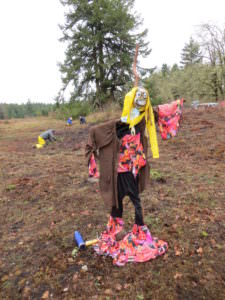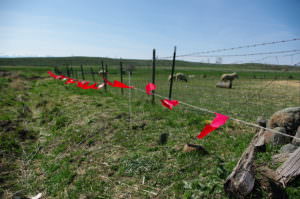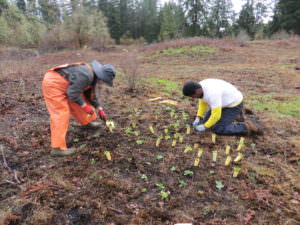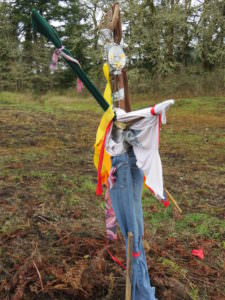Scarecrows – a nonlethal deterrent
How is a Scarecrow like Fladry?
Much like fladry is recommended in some instances as a nonlethal management tool to
prevent predators from attacking livestock, scarecrows serve a similar purpose – to prevent corvids from “predating” on prairie plant plugs.
For the past few years, the Center for Natural Lands Management (CNLM) has planted thousands of “plugs” – small seedlings grown in a tray of plants – on Wolf Haven’s prairie. For the past few years, however, almost none of the plant plugs have been able to establish themselves in the rich prairie soil. A few weeks after each planting, CNLM and Wolf Haven staff discover that most of the plugs have been pulled out of the cold ground. It seems that Wolf Haven’s resident ravens and crows go to work every fall, pulling out the plugs and scattering them across the planting sites. The corvids do not eat the plants; rather, they pull them out for fun, or out of curiosity.
Ravens and crows are extremely intelligent and curious creatures, and are notoriously difficult to completely scare away from a site. Wolf Haven is a sanctuary, and the CNLM is far from heartless, so non-lethal corvid deterrents are a must. Loud bird cannons would likely work to keep the birds at bay, but would also disturb Wolf Haven’s wolves. Such a large area of bird netting or a “Whacky Waving Inflatable Arm Flailing Tube Man” are both too expensive and unwieldy to be placed on the prairie.
The purpose of the plant plugs is to create larval food and nectar sources for a future release of the rare Taylor’s Checkerspot Butterfly. Taylor’s Checkerspots are a newly listed endangered species, which have been in fast decline due to the degradation and fragmentation of its native prairie habitats. In order to help create Taylor’s Checkerspot habitat on Wolf Haven prairie, it is critical this year to have a successful planting.
In September, the three planting areas, totaling about 2.5 acres, had been prepped with a controlled burn in July (to force the native plants into dormancy) and an herbicide treatment (to kill off any surviving invasives). On November 5th, CNLM volunteers teamed up with a few Wolf Haven volunteers and a crew from the Department of Corrections to plant over 12,600 plugs and build scarecrows. In addition to seven scarecrows, six Mylar party balloons were attached to branches and logs on the prairie, and many cassette tape reels, Mylar bird tape, and bright fabric flags were tied throughout the planting areas.
In order to keep the plugs safe, CNLM’s AmeriCorps member for Wolf Haven,
Anne Schuster, moves the scarecrows and balloons every other day, pushing disturbed plugs back in the ground, and putting up more flags and reflective bird tape around the planting sites. Rather than being stuffed with leaves, the scarecrows have clothes loosely hung on them, to create more movement in the wind. The bird tape and flags might scare off small birds, but will hopefully act more as a distraction for the ravens, who might prefer to pull at some shiny material than at plants in the ground.
As of one week after the planting, the scarecrows seem to be doing their job. Only three plugs have been disturbed and pushed halfway out of their holes. The three disturbed plugs are in a row, plus there is a tunnel beneath them and fresh mole hills nearby – so the culprit in this case is probably not a corvid, but a mole.
Anne Schuster,
Center for Natural Lands Management AmeriCorps,
Wolf Haven Outreach and Restoration Technician







